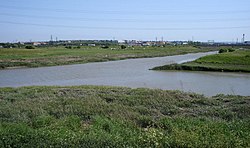River Cray


The River Cray is the largest tributary of the Darent in Metropolitan Kent. It is the prime river of the south-east of the metropolis, rising in Priory Gardens, Orpington, where rainwater percolates through chalk bedrock of the Downs to forms a pond where the eroded ground elevation gives way to impermeable clay. Initially it flows true to form northwards, past industrial and residential St Mary Cray, through St Paul's Cray (where it once powered a paper mill) and through Foots Cray, where it enters the parkland Foots Cray Meadows, flowing under by Five Arches bridge (built in 1781 as part of their designs by Capability Brown). It then flows by restored Loring Hall (c.1760), home of the Lord Castlereagh who took his own life there in 1822. It continues through North Cray and Bexley. It neighbours a restored Gothic-architecture cold-plunge bath house, built around 1766 as part of Vale Mascal Estate. It is then joined by the River Shuttle (a small brook) and then continues through the parkland of Hall Place, which was built for John Champneys in 1540. The Cray turns eastward through Crayford and Barnes Cray to join the Darent in Dartford Creek. The Creek is a well-watered partly tidal inlet (of the Tideway) between Crayford Marshes and Dartford Marshes by a slight projection of land, Crayford Ness. The villages through which the Cray flows are collectively known as "The Crays".
Overview
Clean-ups on the [non-tidal] river and campaigns for responsible angling are organised by the Cray Anglers Conservation Group.[1] The tidal section is effectively monitored and maintained by The Dartford and Crayford Restoration Trust,[2] who also organise Lengthsman duties for the banks. There is a signposted public footpath called the Cray Riverway alongside the river, beginning at Foots Cray Meadows and continuing for 10 miles northwards to the Thames. It is part of the London LOOP. The river is a Site of Metropolitan Importance for Nature Conservation.[3]
Settlements
From south to north, the settlements along the river are:
- Orpington
- St Mary Cray
- St Paul Cray
- A20 road
- Foots Cray
- Bexley Village
- A2 road
- Crayford
References
- ↑ Cray Anglers Conservation Group
- ↑ http://www.bexleytimes.co.uk/news/vital_crayford_creek_clean_up_means_more_boats_could_come_to_area_1_4436976
- ↑ "The River Cray". Greenspace Information for Greater London. 2006. Archived from the original on 24 December 2012. https://archive.is/20121224053159/http://www.gigl.org.uk/igigl/siteDetails.aspx?sID=M106&sType=sinc. Retrieved 8 September 2012.
Bibliography
- Breeze, Andrew (1998). "The Name of the River Cray". Archaeologia Cantiana 118: 372–374. http://www.kentarchaeology.org.uk/Research/Pub/ArchCant/118-1998/118-13.pdf.
Outside links
- Map of the source: 51°22’51"N, -0°6’24"E
- Map of the mouth: 51°27’43"N, -0°12’38"E